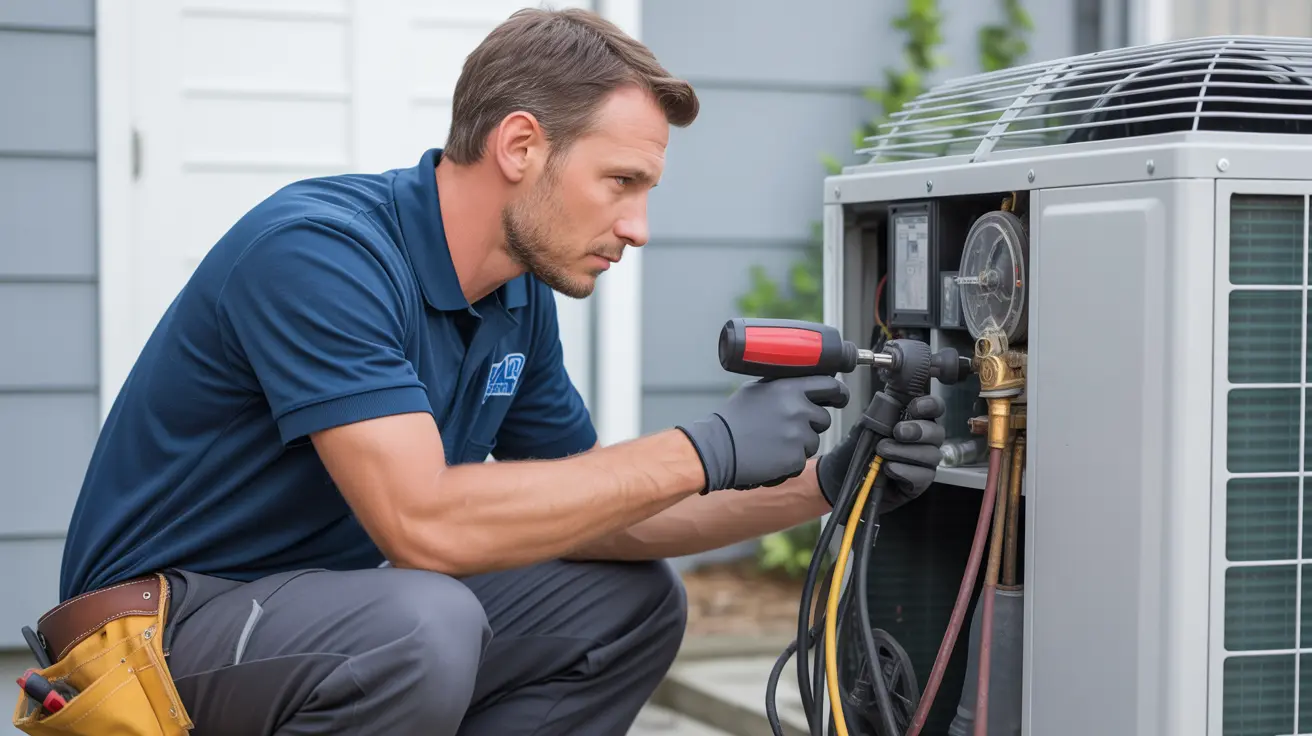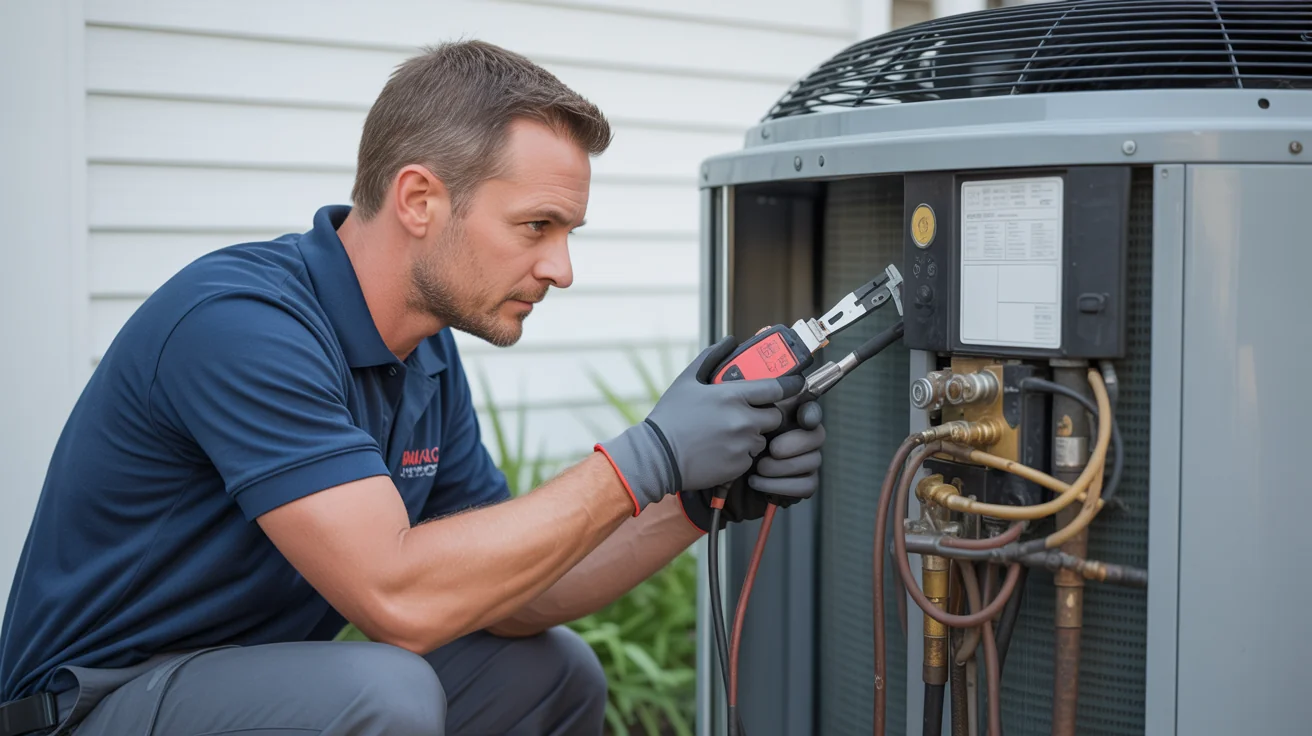Thermostat Says Cooling But Not Cooling?
Thermostat says cooling but house won't cool down? North Texas HVAC pro reveals the real causes and fixes, from simple DIY to calling for help.

- Start With the Stupidly Obvious Stuff
- When Your Thermostat Is Actually Lying to You
- The Frozen Evaporator Coil Situation
- The Capacitor Problem Nobody Talks About
- When Smart Thermostats Get Stupid
- The Ductwork Disaster
- The “It’s Not the AC” Problems
- When to Give Up and Call Someone
+ 3 more sections below...
- Start With the Stupidly Obvious Stuff
- When Your Thermostat Is Actually Lying to You
- The Frozen Evaporator Coil Situation
- The Capacitor Problem Nobody Talks About
- When Smart Thermostats Get Stupid
- The Ductwork Disaster
- The “It’s Not the AC” Problems
- When to Give Up and Call Someone
+ 3 more sections below...
When a thermostat displays “cooling” but the house isn’t cooling, the most common causes are a tripped breaker, clogged filter causing a frozen coil, failed capacitor, or a faulty thermostat temperature sensor. Check both the indoor and outdoor unit breakers (they’re often on separate circuits), replace your air filter if it’s dirty, and verify the outdoor unit fan is spinning. If the outdoor unit hums but the fan doesn’t move, you likely have a failed capacitor ($150-$350 repair). Set the thermostat to 60°F for 5 minutes—if the AC doesn’t kick into high gear, the thermostat itself may be faulty.
It’s 103 degrees in Frisco. Your thermostat says “cooling.” The little snowflake icon is on. Set temp: 72. Current temp: 84.
And climbing.
I got this call three times yesterday. Same story every time. The homeowner’s standing there, sweat running down their face, pointing at the thermostat like it personally betrayed them. (Which, honestly? Sometimes it has.)
Last Tuesday, I drove out to a house in McKinney where the owner had already called two other companies. Both techs told him he needed a new AC unit. $8,000 minimum. I found a tripped float switch in his attic. Fixed in 12 minutes. Cost him $89 for the diagnostic.
Not every fix is that simple. But you’d be surprised how many are.
Start With the Stupidly Obvious Stuff
I know you’ve checked these things. Check them again anyway. I’ve been doing this for 15 years and I still sometimes miss the obvious:
The breaker. Not just the AC breaker – check both the indoor and outdoor unit breakers. Sometimes one trips and the other doesn’t. Your thermostat still lights up because it’s on a different circuit. Had a customer in Allen last month who swore up and down she checked the breakers. Turns out her husband had labeled them wrong when they moved in. The actual AC breaker was marked “garage outlets.”
The filter. Pull it out. Hold it up to the light. If you can’t see through it, that’s your problem. A clogged filter makes your system freeze up. Literally. Ice forms on the coils, blocks airflow, and your house stays hot while the thermostat thinks everything’s fine.
Here’s what nobody tells you: those “3-month” filters? In North Texas summer, with all our dust and allergens? They last maybe 6 weeks. Maybe.
The outdoor unit. Walk outside. Is it running? No? There’s your problem. Is it running but the fan’s not spinning? Different problem. Is it covered in cottonwood fuzz, grass clippings, or (this actually happened) your kid’s art project that blew off the patio table? Yeah, that’ll do it.
When Your Thermostat Is Actually Lying to You
Got a programmable thermostat from 2008? A Honeywell T6 that’s been acting weird lately? That fancy Nest you installed yourself?
Thermostats fail in weird ways. They don’t usually just die completely. They get… confused.
Two weeks ago in Plano: Customer’s thermostat showed 74 degrees. House felt like 85. I checked with my infrared thermometer – 83.7 degrees at the thermostat location. The temperature sensor had failed. The thermostat genuinely thought it was 74, so it wasn’t calling for cooling.
Smart thermostats are especially fun. (That’s sarcasm.) Your Nest might be in Eco mode and you don’t know it. Your Ecobee might’ve lost WiFi connection and defaulted to some random schedule. I’ve seen a Honeywell Lyric decide that 78 degrees was close enough to 72 and just… stop trying.
Quick test: Set your thermostat to 60 degrees. Way below room temperature. Wait five minutes. Go outside. Is the AC running hard? No? Your thermostat might be the problem.
But here’s the thing – sometimes it’s not the thermostat’s fault. It’s doing exactly what it’s supposed to do. The problem is somewhere else.
The Frozen Evaporator Coil Situation
This one’s sneaky. Your system can be completely frozen while still “running.”
Walk to your inside unit (usually in the attic, garage, or closet). Listen carefully. Hear air moving through the vents? No? But the fan’s running? You’re frozen.
Turn the system off. Not to “fan only” – completely off. Go look at the coil if you can access it safely. See ice? That’s your culprit.
You need to let it thaw completely. We’re talking 4-6 hours. Maybe overnight. Run just the fan (not cooling) to speed it up. Put towels down because it’s going to drip. A lot.
But here’s what matters: WHY did it freeze?
- Dirty filter (70% of the time)
- Low refrigerant (20% of the time)
- Blower motor issues (8% of the time)
- Dirty evaporator coil (2% of the time)
That low refrigerant one? That’s not a DIY fix. You’ve got a leak somewhere. And despite what your neighbor says, you can’t just “top it off” every summer. That’s like adding oil to a car that’s leaking oil. Sure, it works for a while, but you’re not fixing anything.
The Capacitor Problem Nobody Talks About
Your AC has these things called capacitors. Think of them like batteries that give your motors a boost to start up. When they fail – and in Texas heat, they fail a lot – weird stuff happens.
Last Thursday, house in The Colony. AC would run for exactly 3 minutes, then stop. Thermostat still said “cooling.” Customer had already replaced the thermostat himself. Spent $200 at Home Depot.
It was a failing capacitor. $35 part. Took me 15 minutes to replace.
How do you know it’s a capacitor? The outdoor unit might:
- Hum but not start
- Start then stop quickly
- Run but the fan doesn’t spin
- Make a clicking sound when it tries to start
You can test a capacitor with a multimeter if you know what you’re doing. If you don’t know what you’re doing, don’t. Those things store electricity. I’ve seen DIY warriors get knocked on their backside. It’s not worth saving $200 to end up in the ER.
When Smart Thermostats Get Stupid
I installed a Nest for a customer in Frisco last year. This summer, she calls: “The Nest says it’s cooling but nothing’s happening.”
Turns out, the Nest had decided her schedule meant she wasn’t home between 9 AM and 5 PM. It was “pre-cooling” at 8 AM (when electricity was cheaper) then coasting until 5 PM. Except you can’t coast through a Texas afternoon when it’s 105 outside.
Another one: Customer in Allen with an Ecobee. Beautiful install. Worked great for two years. Then their power company enrolled them in some “energy saving program” that let the power company control their thermostat during peak hours. They were literally turning off her AC remotely from 3-6 PM every day.
She had no idea she’d signed up for it. Buried in the fine print of some rebate program.
The Ductwork Disaster
Sometimes your AC is working perfectly. The thermostat’s fine. But the cold air isn’t making it to your rooms.
Happened in Prosper last month. Upstairs bedrooms stayed hot no matter what. AC running constantly. Electric bill through the roof. Found a disconnected duct in the attic. All that cold air was just cooling the attic. The duct had probably been loose for years and finally fell off completely.
Another time in McKinney: squirrels. Squirrels had torn through the flexible ductwork to build a nest. Customer was essentially air conditioning a squirrel family.
If certain rooms won’t cool but others are fine, or if your energy bills suddenly spike, get someone to check your ductwork. And no, duct tape doesn’t actually work on ducts. (I know, the irony kills me too.)
The “It’s Not the AC” Problems
Your house has 14 can lights in the ceiling? Those are basically holes to your attic. Hot air pours through them all day.
West-facing windows with no shade? That’s a furnace from 2 PM to 7 PM.
Attic insulation that’s been compressed, moved, or eaten by rodents? Your AC can’t compete with 140-degree attic air leaking into your house.
I told a customer in Little Elm his AC was working perfectly. He didn’t need repairs; he needed insulation and window film. He didn’t believe me. Spent $3,000 on a new system. Still hot. Then spent $1,500 on insulation and his problem went away.
When to Give Up and Call Someone
Look, I respect DIY efforts. But here’s when you need to stop and call a professional:
Electrical issues. If breakers keep tripping, you smell burning, or see scorched wires – stop. This isn’t about your AC anymore; it’s about not burning your house down.
Refrigerant problems. You need an EPA license to handle refrigerant. Plus, if you’re low on refrigerant, you have a leak. Adding more just kicks the can down the road.
Repeated freezing. If your system freezes up again after you’ve changed the filter and let it thaw, something’s wrong that you can’t see.
Compressor issues. If the outdoor unit makes grinding, screaming, or metal-on-metal sounds, shut it off. Running a failing compressor makes everything worse.
You’ve tried everything. Seriously. If you’ve checked everything I’ve mentioned and your house is still hot, there’s something mechanical failing that needs diagnostic equipment to find.
What This Actually Costs to Fix
Since everyone’s going to ask:
- Thermostat replacement: $200-$500 installed
- Capacitor: $150-$350 (depends on type)
- Refrigerant leak repair: $300-$1,500 (depends where it’s leaking)
- Float switch: $150-$250
- Blower motor: $450-$900
- Evaporator coil cleaning: $200-$400
- Ductwork repair: $300-$2,000 (really depends on the damage)
Our diagnostic fee at Jupitair is $89, and we waive it if you approve the repair. That’s standard around here. Anyone charging more than $150 just to look at your system is probably planning to find something expensive to fix.
The Bottom Line
Your thermostat saying “cooling” while your house gets hotter is frustrating. I get it. But it’s usually fixable, and it’s not always expensive.
Start with the simple stuff. Change your filter. Check your breakers. Look at the outdoor unit. Set the thermostat way low and see if the AC actually kicks on.
If that doesn’t work, or if you’re not comfortable troubleshooting, call someone. In this heat, waiting makes everything worse. A frozen coil becomes a dead compressor. A failing capacitor becomes a burned-out motor.
And please – don’t let it run constantly trying to cool down. If it hasn’t caught up in 4 hours, it’s not going to. You’re just running up your electric bill and wearing out parts.
We’re available 24/7 at Jupitair if you need help. Call us at (940) 390-5676. Even if it’s 2 AM and you’ve got family coming tomorrow. We’ve seen it all, fixed it all, and yeah – sometimes it really is just a tripped breaker labeled wrong.
Stay cool, North Texas. Or at least try to.
Gary Musaraj is a certified HVAC technician with 15+ years of experience in North Texas. He’s fixed thousands of “thermostat says cooling but not cooling” calls and only been stumped twice. (Both times involved creative DIY wiring that would make an electrician cry.)
Sources & References
The troubleshooting guidance and repair cost estimates in this article are based on the following authoritative sources:
- U.S. Department of Energy - Air Conditioning - AC operation and maintenance guidance
- ENERGY STAR - Heating and Cooling - Thermostat and equipment efficiency
- EPA - Refrigerant Regulations - Refrigerant handling requirements (EPA Section 608)
- ACCA - Air Conditioning Contractors of America - Industry standards and best practices
- NATE - North American Technician Excellence - Technician certification standards
- Consumer Product Safety Commission - Electrical safety guidelines
- Texas Department of Licensing - HVAC - State contractor licensing requirements
Last Updated: December 2025


